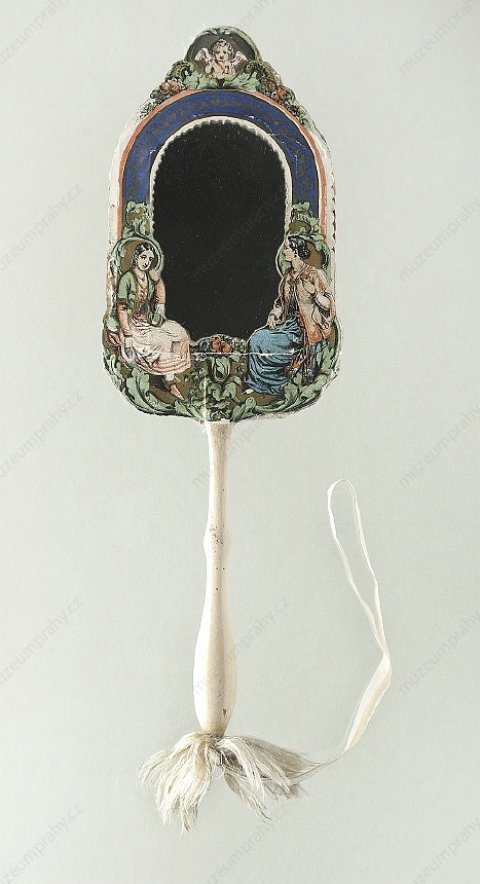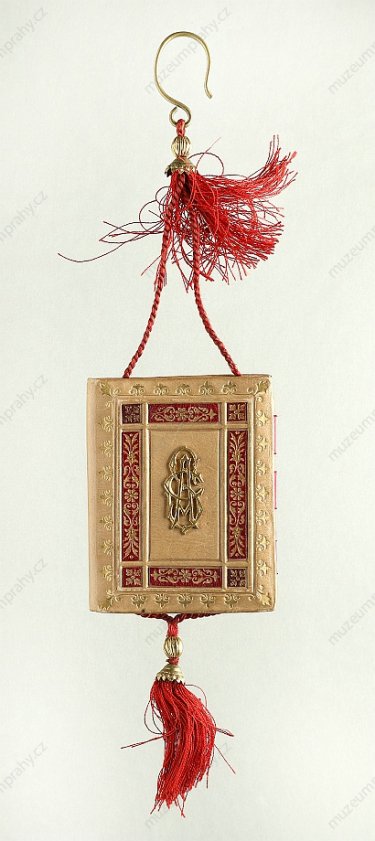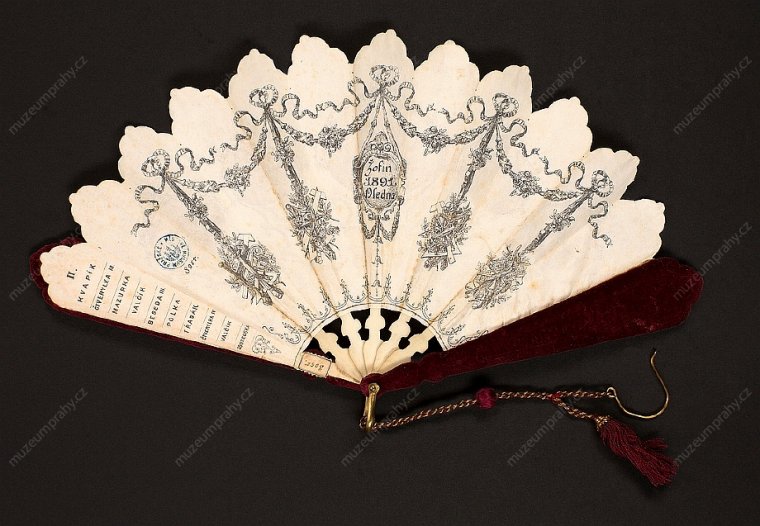Asking for a Dance–Dance Cards and Fans from the Second Half of the 19th Century

Subtle dance cards and ingenious fans give evidence of the unparalleled boom of balls, dance parties, and social life of Prague inhabitants during the second half of the 19thcentury. At the same time, they bear witness to the highly developed rules of contemporary etiquette.
The main dance season in Prague was related to the Shrovetide period, from the beginning of the year to Ash Wednesday. The second, less spectacular season took place outdoors from spring to autumn. The halls on Barvířský (Žofín) and Střelecký islands provided dancing opportunities while summer parties were organised at Stromovka and Štvanice; Měšťanská beseda was a key social centre. In addition to private balls and parties, various institutions organised dance parties, such as the faculties of the Prague University and burgher guards; beginning in the 1860s, the involvement of Prague clubs and organisations including charities in the organisation of balls gradually increased. Masquerade balls, referred to as merendy (merriments) or reduty were rather remarkable and were regularly organised by Umělecká beseda.
Similarly, šibřinky (masquerade parties) were organised by the Sokol movement. Furthermore, the Czech national balls (later Národní besedy) represented the phenomenon of the actively formed nation-oriented society. The multifarious character of balls and dance parties in Prague as well as the extent of originality, wit, and taste of their organisers are aptly reflected in dance cards which are abundant in the City of Prague Museum collection. Ball organisers commonly published dance cards during the 19th and 20th centuries. They came with ball tickets.
Dance cards were subtle booklets or diaries embellished with a printed date and place of the event, sometimes supplemented with verses by Czech poets. Dance cards were equipped with small metal hooks to fasten them onto a dress or handbag and an essential miniature pencil used by ladies and gentlemen to write the name of the dancer on the line of the particular dance. Dance cards came in different versions, from lapidary concertina books with an embossed envelope over more pompous notebooks resembling miniature velvet book bindings to sophisticated original artistic compositions combining paper, metal, textile, tassels, and feathers whose form many times referred to the ball organiser.
Similar to dance cards, fans were a decorative and practical accessory of ladies as well as a coquettish means of communication; fans came back into fashion before the mid19th century. Observing the historical trends, their folding paper sheets were decorated with painted or lithographic scenes; later , fans made of or decorated by feathers became popular as well as laced and embroidered tulle fans combined with pearly ribs and brise fans formed by a set of engraved ribs connected with a silk ribbon.
Several lithographdecorated examples form a special collection. Combining the fan and dance card functions, they were made to commemorate the Slavic balls in Prague in 1849 and in Vienna a year earlier.
Plough-shaped dance card, Ball of Prague Business Club, 19 February 1873, Aug. Klein, Vienna,
paper, metal, silk, H 007 075.
Dance card in the form of framed newspaper, Ball of German Students, 29 January 1868, Mittag & Wildner, Prague,
paper, metal, wood, H 023 650.
Dance card in the form of abook with apharmacy emblem, Ball of Czech Pharmacy Students, 2 March 1882, K.Just Bookbindery, Prague,
paper, bone, silk, metal, H 026 919.
Dance card in the form of a scroll in a tube with legal emblems, Ball of the Všehrd Club of Lawyers in Prague, 13 March 1884, K. Just Bookbindery, Prague,
paper, silk, metal, wood, H 032 516.
Mirror-shaped dance card, Slavic Ball (Slavjanski bal), 17 February 1850, draft by A.Daněk, lithograph by R.Kolarž,
paper, speculum metal, silk, wood, H 033 519.
Dance card in the form of a section sign with legal symbols, dance party of lawyers, 8 March 1882, K. Just Bookbindery, Prague,
paper, metal, silk, wood, H 037 696.
Dance card of the Jubilee Národní Beseda Ball at Žofín, 26 January 1898, Pomněnky Almanac for the 50th anniversary of Národní Beseda, Bělský & Ježek, Prague,
paper, silk, wood, H 037 704.
Dance card in the form of abook in printed leather binding, Ball of the Academic Club of Readers in Prague, 12 January 1887, K.Just Bookbindery, Prague,
paper, leather, silk, metal, wood, H 037 949.
Dance card featuring the relief of Prague Student J. Max, Ball of the Literary and Rhetoric Slavia Club in Prague, Žofín, 7 January 1891, K. Just Bookbindery, Prague,
paper, plush, silk, glass, photograph, metal, H 037 951.
Flacon-shaped dance card, Masquerade Ball of Měšťanská beseda in Karlín, 5 February 1894, Atelier Liska, Prague,
paper, plush, metal, H 037 958.
Dance card in the form of a mother-of-pearl shield with an apothecary emblem, Elite Ball of Pharmacy Students of Czech University, 20 February 1889, K. Just Bookbindery, Prague,
paper, mother-of-pearl, silk, metal, wood, H 044 882.
Dance card in the form of afan featuring the views of architecture at the General Land Centennial Exhibition in Prague in 1891, Ball at Žofín, 19 January 1891, Žofín,
paper, pressed velvet, metal, H 008 055.
Dance card in the form of afan made of printed and coloured paper with depictions of students, Student Ball, 17 January 1849, Prague,
paper, silk, lithograph, H 019 894.
Paper fan with bone ribs and two-sided decoration of the Rococo Revival period, polychrome and gilt print, carved and gilt ribs, c. 1850–1860,
paper, bone, feathers, silk, H 018 620.
Bone fan with cut-out decoration, possessed by the Portheim family, c. 1880–1890,
bone, silk, H 033 670.
Lace fan with a painted silk medallion and mother-of-pearl ribs, possessed by the Portheim family, before 1900,
silk, mother-of-pearl, H 033 672.
Paper fan with a wooden frame, printed coloured depiction of the garden restaurant in Stromovka, Fasching 1880, sig. Rosenberg,
paper, wood, metal, H 086 756.


























